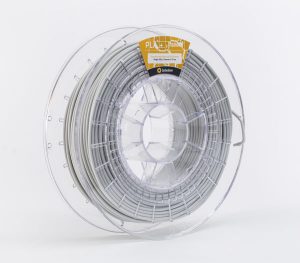
(L to R) VTT Polymer Pilot unit employees: Sini-Tuuli Rauta, Jari-Pekka Kankaanpää, Satu Pasanen and Timo Flyktman [Image: VTT]
“This is the first product of a family that will be sold as a finished 3D filament and in a granular format, as well,” said Carbodeon CEO Vesa Myllymäki. “VTT has been a long-term, reliable partner in this development, and has reacted to our needs quickly.”
The Technical Research Centre of Finland (VTT) worked with Carbodeon to create methods for evenly dispersing the nanodiamonds in the filament to create a PLA composite optimized for 3D printing and produced at an industrial scale. VTT has also tested the material and prints made from it.
“Using our chemical pilot devices, we at VTT produced the nanodispersed material required for the melt processing, and thus supported the creation of a new product,” said Jarmo Ropponen, Research Team Leader at VTT’s chemical pilots.
Nanodiamonds are diamond particles produced by explosions, and they are among the most thermally conductive and hardest materials known. There are some health concerns about nanosized particles if inhaled, with studies showing that they can cause oxidative stress to the heart, lungs and brain. However, good ventilation is suggested as a way to mitigate the risk, just as it is suggested for any type of 3D printing material. Carbodeon’s nanodiamonds have been shown to be non-toxic and suitable for a range of applications according to EPA and REACH assessments.
 Although they are used in very low concentrations, the nanodiamonds in the material can still improve performance significantly. UDiamond filaments contain nanodiamond particles with a diameter of 4-6 nm.
Although they are used in very low concentrations, the nanodiamonds in the material can still improve performance significantly. UDiamond filaments contain nanodiamond particles with a diameter of 4-6 nm.
“The melt processing of plastics became easier and the mechanical characteristics were improved with the introduction of nanodiamonds,” said Satu Pasanen, Research Scientist at VTT in charge of the plastic piloting in the development. “Based on the preliminary tests, the modulus of the 3D-printed test pieces was improved at best by more than 200% compared to the PLA-based filament already on the market. VTT´s Polymer Pilot produced the first 600 kg material batch, which Carbodeon had refined into a commercial product.”
Carbodeon has extensive patent coverage for its nanodiamond materials. the uDiamond material is suitable for both professional and consumer-level FFF/FDM 3D printers, and is no more expensive than much standard filament, costing only €35 for a 500g spool. You can learn more about uDiamond, and place an order for purchase, at Carbodeon’s website.
Discuss this and other 3D printing topics at 3DPrintBoard.com or share your thoughts below.
[Source: VTT]
Subscribe to Our Email Newsletter
Stay up-to-date on all the latest news from the 3D printing industry and receive information and offers from third party vendors.
You May Also Like
Gorilla Sports GE’s First 3D Printed Titanium Cast
How do you help a gorilla with a broken arm? Sounds like the start of a bad joke a zookeeper might tell, but it’s an actual dilemma recently faced by...
Nylon 3D Printed Parts Made More Functional with Coatings & Colors
Parts 3D printed from polyamide (PA, Nylon) 12 using powder bed fusion (PBF) are a mainstay in the additive manufacturing (AM) industry. While post-finishing processes have improved the porosity of...
$25M to Back Sintavia’s Largest Expansion of Metal 3D Printing Capacity Since 2019
Sintavia, the digital manufacturing company specializing in mission-critical parts for strategic sectors, announced a $25 million investment to increase its production capacity, the largest expansion to its operations since 2019....
Velo3D Initiates Public Offering in a Bid to Strengthen Financial Foundations and Drive Future Growth
Velo3D (NYSE: VLD) has been among a number of publicly traded 3D printing firms that have attempted to weather the current macroeconomic climate. After posting a challenging financial report for 2023,...
































